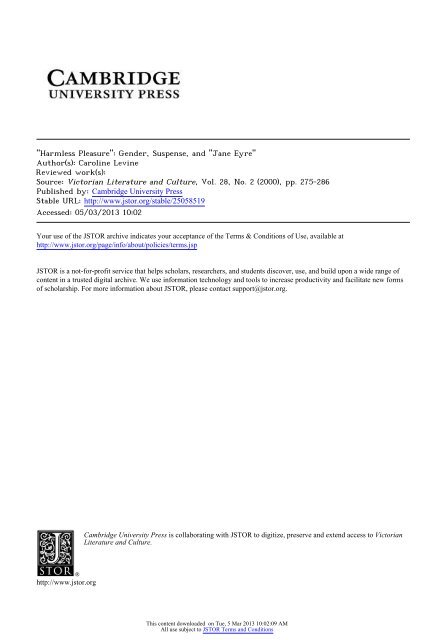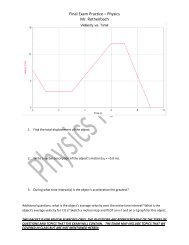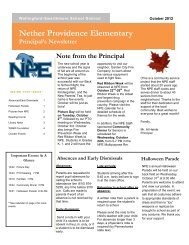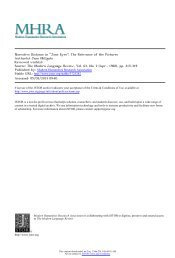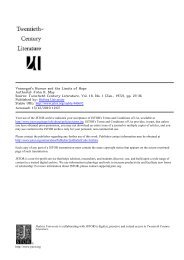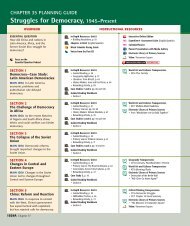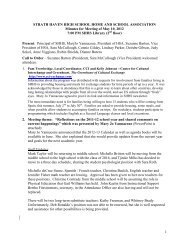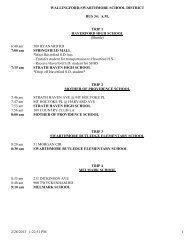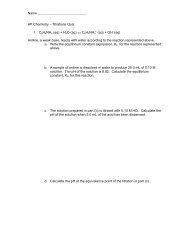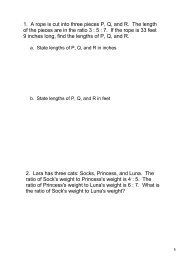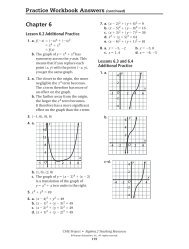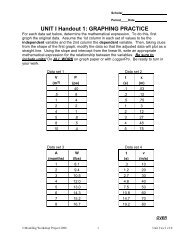"Harmless Pleasure": Gender, Suspense, and "Jane Eyre"
"Harmless Pleasure": Gender, Suspense, and "Jane Eyre"
"Harmless Pleasure": Gender, Suspense, and "Jane Eyre"
Create successful ePaper yourself
Turn your PDF publications into a flip-book with our unique Google optimized e-Paper software.
"<strong>Harmless</strong> Pleasure": <strong>Gender</strong>, <strong>Suspense</strong>, <strong>and</strong> "<strong>Jane</strong> Eyre"Author(s): Caroline LevineReviewed work(s):Source: Victorian Literature <strong>and</strong> Culture, Vol. 28, No. 2 (2000), pp. 275-286Published by: Cambridge University PressStable URL: http://www.jstor.org/stable/25058519 .Accessed: 05/03/2013 10:02Your use of the JSTOR archive indicates your acceptance of the Terms & Conditions of Use, available at .http://www.jstor.org/page/info/about/policies/terms.jsp.JSTOR is a not-for-profit service that helps scholars, researchers, <strong>and</strong> students discover, use, <strong>and</strong> build upon a wide range ofcontent in a trusted digital archive. We use information technology <strong>and</strong> tools to increase productivity <strong>and</strong> facilitate new formsof scholarship. For more information about JSTOR, please contact support@jstor.org..Cambridge University Press is collaborating with JSTOR to digitize, preserve <strong>and</strong> extend access to VictorianLiterature <strong>and</strong> Culture.http://www.jstor.orgThis content downloaded on Tue, 5 Mar 2013 10:02:09 AMAll use subject to JSTOR Terms <strong>and</strong> Conditions
<strong>Gender</strong>, <strong>Suspense</strong>, <strong>and</strong> <strong>Jane</strong> Eyre 281human life, <strong>and</strong> possesses the gift of being able to write as he thinks <strong>and</strong> feels. There is avigourin all he says,a power which fixes the reader's attention, <strong>and</strong> a charm about his"style"<strong>and</strong> "diction" which fascinates while it edifies. (9)After setting the new writer in the context of "serious" male novelists, this reviewer makesabsolutely clear what for him constitute the incontrovertible attributes of masculinewriting. Mind triumphsoverbody,reason conquers feelings, <strong>and</strong> the affections bringus tomoral maturity. In the prose, we find vigor, power, <strong>and</strong> charm. Women are not capable ofsuch intellectual, rational, powerful, <strong>and</strong> moral work ? which means that no woman couldhave writtenthe novel.Charlotte Bront? wrote that this particular review, with its dismissals of feminine skill<strong>and</strong> its affirmations of masculine morality, gave her "much pleasure" (Letters 564). Andsurely, in this context, her pleasure begins to make sense. Like Rochester, her veiledidentity prompts her audience to divulge their innermost feelings, <strong>and</strong> more skillful thanher hero, Bronte's authorial strategy overwhelmingly succeeds. Her "little mystery," hersuggesting <strong>and</strong> withholding, her erotic dance of identity: this veiling provokes the literaryworld to reveal its complacent blunders <strong>and</strong> rigid misconceptions, <strong>and</strong> it yields Bront? theopportunity, eventually, to put them all to shame. Emergingas a powerful critic ofcontemporary assumptions about men's <strong>and</strong> women's writing, Charlotte Bront? uses thetechniques of suspenseful equivocation to make a significant political point.At this juncture,we may return to the mysteries of <strong>Jane</strong> Eyre. It is here that we findour proof that Bront? wasadept at the stratagems of suspense, <strong>and</strong> we might ask, in turn,whether her plotting in the public sphere throws light on the operations of her narrative.That is, if the veils of suspense serve a radical political purpose among the Victorianliterati, mightwe say the same for the plotted mysteries of <strong>Jane</strong> Eyre?Literary critics have not been inclined to seesuspenseful narrative as a radical form.Powerful <strong>and</strong> manipulative, end-oriented narrative arbitrarily withholds particular morsels of knowledge, while signaling that withholding, <strong>and</strong> thus provokes readers to desirethe very conclusions the narrative has prearranged. It is among the most effective of toolsfor training readerly desire, <strong>and</strong> therefore an ideal vehicle for the orchestration of ideol8ogy. But Charlotte Bront? might prompt us to take a second look at the political potentialof plot. After all, it is in the space between veiling <strong>and</strong> unveiling that we reveal ourselves.Mysteries offer us the opportunity for speculation, <strong>and</strong> in speculating,wenecessarilyoverstep the bounds of the evidence, imposingour ownpreconceptions <strong>and</strong> desires on theworld that we encounter. In the end, the solution to the mystery, if it is in the leastunconventional, exposes narrowly conventional convictions as partial,as misguided,asinsufficient. Such is Charlotte's ownaccomplishment when she unveils herself <strong>and</strong> publiclysolves her "little mystery." But even when the ending confirms <strong>and</strong> resettles conventions,the delay before that resettling leaves them pointedly up in the air, <strong>and</strong> part of the pleasureof reading suspenseful narrative is the?knowledgeeven the?anxiety that the worldmay not, in the end, conform to our ideas of it. The very experience of suspensefuluncertainty proves that there is more than one credible ending to the narrative, more thanonepotentially plausible solution to the mystery. In this context, closure does not so muchdictate an arbitrary conclusion, as it compelsus to recognize the otherness of the world,the ever-present possibility that the facts may refuse to validate our prejudices. <strong>Suspense</strong>ful narrative, in short, teaches us that the world may controvert our expectations, disprovThis content downloaded on Tue, 5 Mar 2013 10:02:09 AMAll use subject to JSTOR Terms <strong>and</strong> Conditions
282 VICTORIAN LITERATURE AND CULTUREing our cherished beliefs <strong>and</strong> convictions. If we are to become capable of setting aside ourownpreconceptions in order to hear the other, then we must indeed learn to suspendjudgment. Viewed in this light, plot becomes one of the most subversive of literary forms.Not surprisingly, the text o? <strong>Jane</strong> Eyre offers us a usefully illustrative example. After aseries of seductive checks <strong>and</strong> equivocations relating to <strong>Jane</strong>, Rochester goes to visit thebeautiful Blanche Ingram. As <strong>Jane</strong> waits, suspended, for his return, she seeks to convinceherself that she has been wrong about his interest in her: desiring but not knowing, she resolves to put her faith in conventional wisdom, which tells her that "a dependent <strong>and</strong> a novice" could never be loved by "a gentleman of family, <strong>and</strong> a man of the world." She preachesto herself, in the style of a lecture or sermon, speaking in general maxims: "It does no goodfor a woman to be flattered by her superior, who cannot possibly intend to marry her" (153;ch. 14). Men in superior positions cannot intend to marry their inferiors. This general law isan example of what Rol<strong>and</strong> Barthes calls the "implicit proverbs" of the cultural code ?"written in that obligative mode by which the discourse states a general will, the law of a so...cietya maxim, a postulate" (100). Like the insistence that respectablewomen cannotwrite with the vigor <strong>and</strong> charm of the male pen, the notion that a superior can never intendto marry a dependent is broadly axiomatic, sweeping enough to include the world of thereader as well as the world of the text. And this idea is certainly the prevailing orthodoxy,as<strong>Jane</strong> here makes clear. The maxim is also a comprehensive representation of the world, ageneralized description of the "real," purporting to swallow up all particular cases.But <strong>Jane</strong>'s experience will work to invalidate this representation, unsettling the universalizing statements of "common sense." In good realist fashion, that is, her narrativeupsets conventional ways of seeing <strong>and</strong> puts forward a new <strong>and</strong> more truthful image of thereal. We soon learn that a gentleman of family <strong>and</strong> man of the world can indeed intend tomarry a dependent <strong>and</strong> a novice, which goes to prove that the social authorities?thegeneral will ? have got it wrong. After learning to suspend judgment,wepresumablyrevise ourunderst<strong>and</strong>ing accordingly. But no sooner have we come to believe in thisgentleman's good intentions, than we discover that Rochester does not, in fact, intend tomarry <strong>Jane</strong>, at least technically speaking. And when in fact she does marry him, she is nolongera "dependent <strong>and</strong> a novice." In this double about-face, we return to ourstartingpoint, but in the process we have been forced to admit, however unwillingly, that the very?open-endedness the?pleasurable uncertainty of the plot suggests the genuine plausibility of alternative endings. By definition, suspense casts doubt on the necessity of aparticular ending. By the time the narrative has finally resettled <strong>Jane</strong>'s "implicit proverb,"it has effectively thrown all automatic faith in the dictates of common sense into question.On the most general level, <strong>Jane</strong>'s lesson invites us to nurture a skepticism about maxims<strong>and</strong> generalizing representations, to test sweeping principles against the evidence.A quintessential bildungsroman, what <strong>Jane</strong> Eyre teaches its readers ? from title pageto conclusion?is a vigilant skepticism about our ownassumptions. It should come as nosurprise, therefore, that the heroine models this training for us, learning, little by little, toquestion her ownpreconceptions. For example, having lighted upon Grace Poole as theprobable culprit for the fire in Rochester's bed, she tries to confirm her suspicions. Themorning after the conflagration, <strong>Jane</strong> comes upon Grace sewing curtain rings:There she sat, staid <strong>and</strong>taciturn-looking,as usual, in her brown stuff gown, her check apron,white h<strong>and</strong>kerchief, <strong>and</strong> cap. She was intent on her work, in which her whole thoughts seemedThis content downloaded on Tue, 5 Mar 2013 10:02:09 AMAll use subject to JSTOR Terms <strong>and</strong> Conditions
<strong>Gender</strong>, <strong>Suspense</strong>, <strong>and</strong> <strong>Jane</strong> Eyre 283absorbed: on her hard forehead, <strong>and</strong> in hercommonplace features, wasnothingeither of theorpaleness desperationone would haveexpectedto see markingthe countenance of a womanwho had attempted murder. ... "I will put her to some test," thought I: "such absoluteimpenetrability is past comprehension." (175-76; ch. 16)<strong>Jane</strong>, as we can glean from the narrative, has neveractuallyseen a murderer, but "one"would "expect"a murderer to look desperate <strong>and</strong> pale. A murderer could not possiblylook so ordinary,so "commonplace." The exceptional, <strong>Jane</strong> suggests, must bear visiblemarks of its difference from the norm. But then, narrative suspense reminds us of what weknow to be true: ourimages <strong>and</strong> expectations may well in fact conflict with "realities"; wemay not know the truth. Knowing that she does not know, <strong>Jane</strong> experiments. "I will puther to some test," <strong>Jane</strong> decides. Since she cannot "penetrate" the appearance, she mustexperimenton it, test it, to find out whether her suspicions do or do not fit the hidden truth.Experimentation, like narrative, suspends the future. Experiments always hold outthe possibility that the facts will show nothing,or worse, that they will prove the hypothesiswrong. The experimenter resolutely tests hypotheses rather than taking them for granted,all the while acknowledging the possibility of failure. <strong>Suspense</strong>, then, is the very substanceof experimentation. And the experiment has been seen as fundamentally radical in character ? resolutely anti-conventional <strong>and</strong> insurgent. As Avital Ronnell puts it: "Theexperimental spirit is ... a vitality that disrupts sedimented concepts <strong>and</strong> social values"(213). Or as John Dewey has it: "The scientific attitude may almost be defined as thatwhich is capable of enjoying the doubtful" (qtd.in Crease 39). To experimentone mustbe willing to suspend one's ownjudgment, to acknowledge the otherness of the world, <strong>and</strong>to imagine its possible resistance to convention. In this light, plotted suspense <strong>and</strong> radicalpolitics again converge.Torn between conflicting solutions to the mysteries of her environment, <strong>Jane</strong>, like herauthor, disrupts orthodox conceptions of femininity. Wondering whether the enigma ofGrace Poole involves a past sexual indiscretion, <strong>Jane</strong> considers the alternatives:Mrs Poole's square, flat figure,<strong>and</strong> uncomely, dry,even coarse face, recurred sodistinctlyto my mind's eye, that I thought, "No; impossible! my supposition cannot be correct. Yet,"suggestedthe secret voice which talks to us in our hearts, "youare not beautiful either,<strong>and</strong> perhaps Mr Rochester approves you; at any rate, you have often felt as if he did."(179; ch. 16)If it is impossible for Rochester to have been in love with the square, dry Grace Poole,then it might be equally impossible that he loves the small, irregular <strong>Jane</strong> Eyre. Either hefollows convention, in which case he cannot love either ? or he is highly unusual, in whichcase he might well love both.<strong>Jane</strong> quells these anxieties, for the moment, by forcinga conventional conclusion: "Icompared myself with her, <strong>and</strong> found we were different. Bessie Leaven had said that I wasquitealady: <strong>and</strong> she spoke truth. . . . And now I looked much better than I did whenBessie saw me" (179; ch. 16). <strong>Jane</strong> here compares the two images <strong>and</strong> arrives at acomforting difference: she is prettier <strong>and</strong> of a higher class than Grace Poole. But, as if tomake absolutely clear that all such conventions are up for grabs, it is immediately afterthis that the narrative introduces Blanche Ingram. If Rochester is interested in outwardThis content downloaded on Tue, 5 Mar 2013 10:02:09 AMAll use subject to JSTOR Terms <strong>and</strong> Conditions
284 VICTORIAN LITERATURE AND CULTUREmarks of class <strong>and</strong> beauty, then Blanche?not <strong>Jane</strong> ? must be his chosen mate. If,however, he is attracted to the hidden <strong>and</strong> the exceptional, why not Grace Poole as easilyas <strong>Jane</strong> Eyre? While we wait for the answers, the narrative casts significant doubt on therelationship between conventional marks of feminine attractiveness <strong>and</strong> their unsettlinglyeccentric alternatives.Skillfully deploying the open-endedness of suspense from beginning to end, CharlotteBront? enforces strict lessons about gender. Much as we may bluster <strong>and</strong> swagger in ourconvictions, there is always the chance that the solution to the mystery may prove uswrong. In a world which confines <strong>and</strong> restricts womenprecisely by conceiving of women'spotential as a limited, known quantity, Bronte's suspense teaches us to doubt, to experiment, to suspend judgment. When it comes to femininity, the veil teaches us to expectsurprises. Which is not such a harmless pleasure after all.Rutgers University, CamdenNOTES1. Responding to the "Biographical Notice," Lewes could hardly contain his thrill at theapparent incongruity: "Curious enough is it to read Wuthering Heights <strong>and</strong> The Tenant ofWildfell Hall, <strong>and</strong> remember that the writers were two retiring, solitary, consumptive girls!Books, coarse even for men, coarse inlanguage<strong>and</strong> coarse inconception,the coarsenessapparently of violent <strong>and</strong> uncultivated men ? turn out to be the productions of two girlsliving almost alone, filling their loneliness with quiet studies, <strong>and</strong> writing these books from asense of duty, hating the pictures they drew, yet drawing them with austere conscientiousness!" (Leader 953). After Charlotte's death, Harriet Martineau tried to justify the disharmony, explainingthat the novels reveal a committed realism, based onexperience,ratherthan an intent to sc<strong>and</strong>alize: "Such an experience as this indicates is really perplexing toEnglish people in general; <strong>and</strong> all that we have to do with it is to bear it in mind whendisposedto pass criticism on the coarseness which, to a certaindegree, pervades the work ofall the sisters, <strong>and</strong> the repulsiveness which makes the tales of Emily <strong>and</strong> Ann really horribleto peoplewho have not iron nerves"(363-64).2. Forexample,Winnifrith <strong>and</strong> Chithampointto Charlotte's"shyness<strong>and</strong>depression"as thereason for her refusal to make the most of her fame(11).Moresearchingly,Kucich claimsthat Charlotte "cultivates psychic withdrawal," but he also argues that this is not so much asign of vulnerability as a kind of power (74 <strong>and</strong> 82).3. Gezari appears to overlook this"pleasure" when she writes that Charlotte shows her "uneasiness" in this passage (17).4. So compelling was the metaphor of the veil that two of the reviewers who responded to the"Biographical Notice" echoed it in the first lines of their reviews. The Examiner wrote: "Ina preface to this volume the author of <strong>Jane</strong> Eyre partially lifts the veil from the history <strong>and</strong>mystery of authorship which has occupied the Quidnuncs of literature for the past two years"(288). And the opening of the Athenaeum review read: "The lifting of that veil which for awhile concealed the authorship of <strong>Jane</strong> Eyre <strong>and</strong> its sister-novels excited in us no surprise"(1368).5. Judd puts to rest the misconception that women writers took male pseudonyms in order tofind publishers, <strong>and</strong> points out that a number of male writers in the? period including?Shelley, Thackeray, Ruskin, <strong>and</strong> Swinburne chose women's names to publishtheir work(251).This content downloaded on Tue, 5 Mar 2013 10:02:09 AMAll use subject to JSTOR Terms <strong>and</strong> Conditions
<strong>Gender</strong>, <strong>Suspense</strong>, <strong>and</strong> <strong>Jane</strong> Eyre 2856. This "checking," for Barthes, is one of the prototypical delays of the hermeneutic code;narrativesourourpique curiosity, provokingdesire for closure, when they offer a "suspended answer (the aphasie stoppage of the disclosure)" (75).7. As Beaty puts it, "though 'edited by' would not necessarily have indicated the kind of novelbeing presented, what it might have been expected to indicate was a work by a well-knownnovelist, acknowledged by name, pseudonym, or the titles of that novelist's other works"(12). Beaty generates a rich reading of the title page by considering texts just precedingorcontemporary with <strong>Jane</strong> Eyre <strong>and</strong> trying to reconstruct the experience of the 1847 readeropening the book for the first time; he looks especially closely at the idea of the "autobiography" <strong>and</strong> the fictional editor. While his work is stimulating <strong>and</strong> useful, it largely overlooksthe veiling that I argue Charlotte Bront? is enjoying here.8. Miller, for example, points to political lessons implied by the end-oriented plot of BleakHouse: "insofar as it arouses a desire forexpeditious,conclusive solutions butonly represents a single agency capable of providing them, the novel subtly identifies the reader'sdem<strong>and</strong> for closure with a general social need for the police, thus continuing... [Dickens's]apologetics for the new forces of order" (Novel 93-94). Barthes reads the stratagems ofsuspenseas "anorganizedset ofonstoppages"the way to orderlyclosure. Plotted narrativeis "linked to classical metaphysics" in that it begins with an incomplete subject who iscompleted <strong>and</strong> fulfilled by the emergence of the truth (76).WORKS CITEDAllott, Miriam, ed. The Brontes: The Critical Heritage. London: Routledge, 1974.Athen um. Unsigned review (28 Dec. 1850): 1368-69. Rpt. In Allott 294-95.Barthes, Rol<strong>and</strong>. S/Z. Trans. Richard Miller. New York: Hill <strong>and</strong> Wang, 1974.Beaty, Jerome. Misreading <strong>Jane</strong> Eyre: A Postformalist Paradigm. Columbus: Ohio State UP, 1996.Bodenheimer, Rosemarie. "<strong>Jane</strong> Eyrein Search of HerStory."Charlotte Bronte's <strong>Jane</strong> Eyre:Modern Critical Interpretations. Ed. Harold Bloom. New York: Chelsea House, 1987. 97-112.Bront?, Charlotte. "Biographical Notice of Ellis <strong>and</strong> Acton Bell." The Brontes: Interviews <strong>and</strong>Recollections. Ed. Harold Orel. Iowa City: U of Iowa P, 1997.133-40.-. <strong>Jane</strong> Eyre. Ed. Michael Mason. Harmondsworth: Penguin,1996.-. The Letters of Charlotte Bront?. Vol. 1 (1829-47). Ed. Margaret Smith. Oxford: Clarendon,1995.Christian Remembrancer. Unsigned review (Apr. 1848). Rpt, in Allott 88-92.Crease, Robert P. The Play of Nature: ExperimentationP, 1993.Era. Unsigned review (14 Nov. 1847): 9. Rpt, in Allott 78-80.Examiner. Unsigned review (21 Dec. 1850). Rpt. in Allott 288.as Performance. Bloomington:U of IndianaGaskell, Elizabeth. The Life of Charlotte Bront?. Oxford: Oxford UP, 1978.Gezari, <strong>Jane</strong>t. Charlotte Bront? <strong>and</strong> Defensive Conduct: The Author <strong>and</strong> the Body at Risk. Philadelphia: U of Pennsylvania P, 1992.Judd, Catherine A. "Male Pseudonyms <strong>and</strong> Female Authority in Victorian Engl<strong>and</strong>." Literature inthe Marketplace: Nineteenth-Century British Publishing <strong>and</strong> Reading Practices. Ed. John O.Jordan <strong>and</strong> Robert C. Patten. Cambridge: Cambridge UP, 1995. 250-62.Kucich, John. "Passionate Reserve <strong>and</strong> Reserved Passion in the Works of Charlotte Bront?."Critical Essays on Charlotte Bront?. Ed. Barbara Timm Gates. Boston: G. K. Hall, 1990. 68-88.[Lewes, George Henry.] Review. Eraser's Magazine 36 (Dec. 1847): 686-95. Rpt. in Allott 83-87.[-. ] Review. Leader (28 Dec. 1850): 953-54. Rpt. in Allott 291-94.Martineau, Harriet. Biographical Sketches 1852-1868. London: Macmillan, 1870.This content downloaded on Tue, 5 Mar 2013 10:02:09 AMAll use subject to JSTOR Terms <strong>and</strong> Conditions
286 VICTORIAN LITERATURE AND CULTUREMiller, D. A. Narrative <strong>and</strong> its Discontents. Princeton: Princeton UP, 1981.-. The Novel <strong>and</strong> the Police. Berkeley: U of California P, 1988.People's Journal. Unsigned review. (Nov. 1847). Rpt. in Allott 80-81.[Rigby, Elizabeth.] Review. Quarterly Review 84 (Dec. 1848): 153-85. Rpt. in Allott 105-12.Ronell, Avital. "The Test Drive." Deconstruction Is/In America: A New Sense of the Political. Ed.Anselm Haverkamp. New York: New York UP, 1995. 200-20.[Whipple, Edwin Percy.] "Novels of the Season." North American Review 141(Oct. 1848): 354-69.Rpt. in Allott 97-99.Winnifrith, Tom, <strong>and</strong> Edward Chitham. Charlotte <strong>and</strong> Emily Bront?: Literary Lives. New York: St.Martin's, 1989.This content downloaded on Tue, 5 Mar 2013 10:02:09 AMAll use subject to JSTOR Terms <strong>and</strong> Conditions


